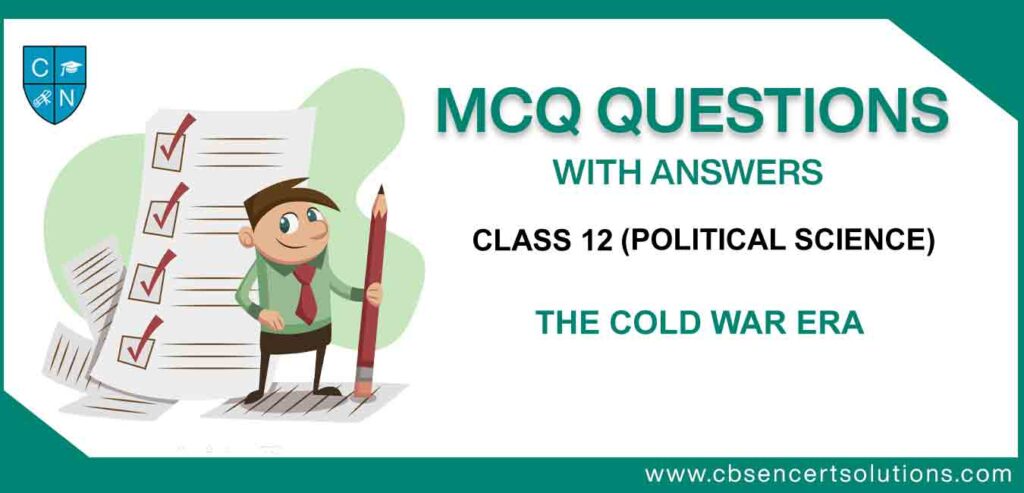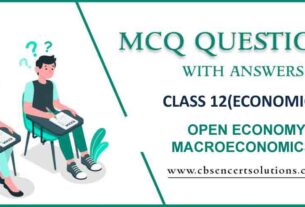Check the below NCERT MCQ Class 12 Political Science Chapter 1 The Cold War Era with Answers available with PDF free download. MCQ Questions for Class 12 Political Science with Answers were prepared based on the latest syllabus and examination pattern issued by CBSE, NCERT and KVS. Our teachers have provided below The Cold War Era Class 12 Political Science MCQs Questions with answers which will help students to revise and get more marks in exams
The Cold War Era Class 12 Political Science MCQs Questions with Answers
Refer below for MCQ Class 12 Political Science Chapter 1 The Cold War Era with solutions. Solve questions and compare with the answers provided below
Question. Which of the following statements about the NIEO is false?
(A) Give the LDCs control over their natural resources.
(B) Obtain access to western markets.
(C) Reduce the cost of technology from western countries.
(D) Provide the developed countries with a greater role in international economic institutions.
Answer
D
Question. Why did US and USSR never fight a direct war against each other?
(A) because their economy exhausted in WW2.
(B) because both did not have any nuclear weapons.
(C) because they understood the destruction caused by the use of atomic bombs.
(D) All of the above
Answer
C
Question. When did Cuban Missile Crisis occur?
(A) 1967
(B) 1962
(C) 1960
(D) 1970
Answer
B
Question. The Cold War is referred to the competition, the tensions and a series of confrontations between the:
(A) United States and the Soviet Union
(B) France and Germany
(C) India and Pakistan
(D) America and Africa
Answer
A
Question. When did the Cold War begin?
(A) After the Second World War
(B) During the Second World War
(C) Between 1914 and 1918
(D) Between 1939 and 1945
Answer
A
Question. Select the correct option for the Alliance and the organization it was formalized into:
(A) The Eastern Alliance was formalized into UNO.
(B) The Western Alliance was formalized into NATO.
(C) The Central Alliance was formalized into SEATO.
(D) The Neutral Alliance was formalized into Peace keeping forces.
Answer
B
Question. When did the American become aware of the weapon placed in Cuba by USSR?
(A) On the first day
(B) One week later
(C) Three weeks later
(D) None of the above
Answer
C
Question. The high point of Cold War was ………………….. .
(A) Cuban Missile Crisis
(B) Atomic bomb attack on Hiroshima and Nagasaki
(C) Establishment of SEATO and CENTO
(D) Establishment of NATO
Answer
A
Question. Warsaw Pact was created in the:
(A) 1935
(C) 1955
(B) 1945
(D) 1965
Answer
C
Question. What were the leaders of USSR worried about in 1961?
(A) That USA will attack China
(B) That USA will be the most powerful nation
(C) That USA will develop more nuclear weapons
(D) That USA will attack Cuba and overthrow Fidel Castro
Answer
D
Question. Write the names of the main countries of Axis Powers.
(A) Germany, Italy, and Japan.
(B) India, Japan, Sri Lanka
(C) Bangladesh, Pakistan, China, India
(D) All of the above
Answer
A
Question. The first non-aligned summit was held in the year 1961 in ………………. .
(A) Venice
(B) Delhi
(C) Belgrade
(D) Dhaka
Answer
C
Question. Which one of the following statements is ‘not correct’ about the ‘Non-Aligned Movement’?
(A) It suggested to the newly independent countries ways to stay out of alliances.
(B) India’s policy of non-alignment was neither negative nor passive.
(C) The non-aligned posture of India served its interests.
(D) India was praised for signing the treaty of friendship with USSR to strengthen NAM.
Answer
D
Question. In which year NAM was established?
(A) 1956
(B) 1960
(C) 1990
(D) 1957
Answer
A
Question. Which of the following statements about the Cold War is wrong?
(A) It was an ideological war between the superpowers.
(B) It was a competition between the US and Soviet Union and their respective allies.
(C) It triggered of an arms race.
(D) The US and USSR were engaged in direct war.
Answer
D
Question. Which set of the countries belonged to the NATO Group?
(A) Poland, Britain, Romania
(B) USA, Czech Republic, France
(C) United Kingdom, France, West Germany
(D) Spain, France, East Germany.
Answer
C
Question. Who was the President of USA during Cuban Missile Crisis?
(A) Abraham Lincoln
(B) John F Kennedy
(C) Bill Clinton
(D) None of the above
Answer
B
Question. In which year CENTO was established?
(A) 1956
(B) 1957
(C) 1958
(D) 1955
Answer
D
Question. Which among the following is not among theobjectives of NAM?
(A) Enabling newly decolonized countries to pursue independent policies
(B) Not to joining any military alliances
(C) Following a policy of neutrality on global issues
(D) Focus on elimination of global economic inequalities
Answer
C
Question. Which of the following countries was not a member of NATO?
(A) France
(B) The U.S.A.
(C) England
(D) None of these
Answer
D
Question. Which of the following statement is true for the Cold War?
(A) The two superpowers were poised for direct confrontations in India (1950 – 53), Gulf (1958 – 62).
(B) The two superpowers were poised for direct confrontations in Berlin only (1958 – 62).
(C) The two superpowers were poised for direct confrontations in Korea (1950 – 53), Berlin (1958 – 62).
(D) The two superpowers were poised for direct confrontations in Korea only (1950 – 53).
Answer
C
Question. Cuba was an ally of ________
(A) USA
(B) USSR
(C) UK
(D) None of the above
Answer
B
Question. Which of the following country was not among the allied powers?
(A) USA
(B) USSR
(C) Germany
(D) Britain
Answer
C
Question. Which conference was held in 1972 by the United Nations?
(A) United Nations conference on trade and development
(B) United Nations conference on investment
(C) United Nations conference on education
(D) United Nations conference on trade and defence
Answer
A
Question. The high point of Cold War was
(A) Cuban Missile Crisis
(B) Atomic bomb attack on Hiroshima and Nagasaki
(C) Establishment of SEATO and CENTO
(D) Establishment of NATO
Answer
A
Question. The western alliance was codified into an organisation named _______
(A) SEATO
(B) CENTO
(C) NATO
(D) NAM
Answer
C
Question. Arena refers to –
(A) Areas where upheaval and war occurred or threatened to occur between the alliance systems but did not cross certain limits
(B) Countries that have agreements to support each other during war
(C) Both A and B
(D) None of the above
Answer
A
Question. Where was the first summit of NAM held?
(A) Tehran
(B) Shimla
(C) Accra
(D) Belgrade
Answer
D
Question. Which of the following statement is not true about India’s response to the cold war?
(A) It raised its voice against the newly decolonised countries becoming part of these alliances
(B) It took particular care in staying away from the two alliances
(C) Both A and B
(D) None of the above
Answer
C
Question. US represented the ideology of ______ and ______
(A) Socialism and Communism
(B) Capitalism and Socialism
(C) Capitalism and liberal democracy
(D) None of the above
Answer
C
Assertion (A) is followed by a statement of Reason (R). Mark the correct choice as:
(A) Both (A) and (R) are true, but (R) is the correct explanation of (A).
(B) Both (A) and (R) are true, but (R) is not the correct explanation of (A).
(C) (A) is true, but (R) is false.
(D) (A) is false, but (R) is true.
Question. Assertion: The roots of NAM went back to the friendship between three leaders — Yugoslavia’s Josip Broz Tito, India’s Jawahar Lal Nehru, and Egypt’s leader Gamal Abdel Nasser — who held a meeting in 1956.
Reason: NAM was established for neutral approach in the situation of the Cold War.
Answer
A
Question. Assertion: The US President, John F. Kennedy, and his advisers were reluctant to do anything that might lead to full-scale nuclear war between the two countries.
Reason: The possible clash (Cold War) between the two countries was avoided.
Answer
C
Question. Assertion: Huge stocks of arms were considered necessary to prevent wars from taking place.
Reason: Since the Cold War did not eliminate rivalries between the two alliances, mutual suspicions led them to arm themselves to the teeth and to constantly prepare for war.
Answer
A
Question. Assertion: Soviet Union, decided to convert Cuba into a Russian base.
Reason: Cuba was an ally of the Soviet Union and received both diplomatic and financial aid from it.
Answer
B
Question. Assertion: The Cold War was not simply a matter of power rivalries, of military alliances, and of the balance of power.
Reason: These were accompanied by a real ideological conflict as well, a difference over the best and the most appropriate way of organizing political, economic, and social life all over the world.
Answer
A
Question. Assertion: NAM gave the members right not to choose any bloc over the other and yet gave them the right to deal with the global issues.
Reason: Jawahar Lal Nehru isolated India from the entire world.
Answer
C
Question. Assertion: Smaller states got the promise of protection, weapons, and economic aid against their local rivals, mostly regional neighbours with whom they had rivalries.
Reason: The smaller states in the alliances used the link to the superpowers for their own purposes.
Answer
A
Question. Assertion: The Cuban Missile Crisis was only one of the several crisis that occurred during the Cold War.
Reason: The Cold War also led to several shooting wars.
Answer
B
Question. Assertion: The installation of these weapons put the US, for the first time, under fire from close range and nearly doubled the number of bases or cities in the American mainland which could be threatened by the USSR.
Answer
A
Question. Assertion: The two sides understood that war might occur in spite of restraint.
Reason: Because they wanted to confront each other with weapons.
Answer
C
Question. Assertion: The Western Alliance was formalized into an organization, the North Atlantic Treaty Organization (NATO), which came into existence in April 1949.
Reason: The Eastern Alliance, known as the CENTO, was led by the Soviet Union.
Answer
C
Question. Assertion: Under these circumstances (Cold War), many of the newly independent countries, after gaining their independence from the colonial powers such as Britain and France, were worried that they would lose their freedom as soon as they gained formal independence.
Reason: The Cold War threatened to divide the world into two alliances.
Answer
A

We hope you liked MCQ Class 12 Political Science Chapter 1 The Cold War Era with answers provided above. Incase you have any questions please post them in the comments section below and our Political Science teachers will provide a response.
